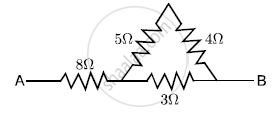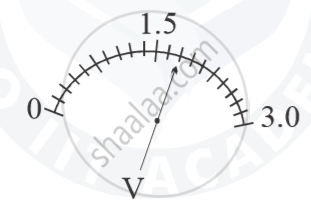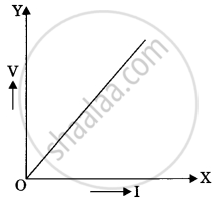Advertisements
Advertisements
Question
If the potential difference across the ends of a conductor is 220 V and the resistance of the conductor is 44 Ω (ohm), then the current flowing through is _________.
- 0.2 A
- 0.5 A
- 2 A
- 5 A
Solution
(d) 5 A
V = IR
∴ 220 V = I x 44 Ω
Or, `"I"=(220"V")/(44Omega)=5"A"`
APPEARS IN
RELATED QUESTIONS
Will current flow more easily through a thick wire or a thin wire of the same material, when connected to the same source? Why?
The relationship between the potential difference and the current in a conductor is stated in the form of a law.
1) Name the law.
2) What does the slope of V-I graph for a conductor represent?
3) Name the material used for making the connecting wire.
Write the formula of resistivity
When a 12 V battery is connected across an unknown resistor, there is a current of 2.5 mA in the circuit. Calculate the value of the resistance of the resistor.
The unit of electrical resistance is:
(a) ampere
(b) volt
(c) coulomb
(d) ohm
The graph between V and I for a conductor is a straight line passing through the origin.
Which law is illustrated by such a graph?
How should the two resistances of 2 ohms each be connected so as to produce an equivalent resistance of 1 ohm?
How much energy is consumed when a current of 5 amperes flows through the filament (or element) of a heater having resistance of 100 ohms for two hours? Express it in joules.
A resistance of 40 ohms and one of 60 ohms are arranged in series across 220 volt supply. Find the heat in joules produced by this combination of resistances in half a minute.
State Ohm’s law and draw a neat labelled circuit diagram containing a battery, a key, a voltmeter, an ammeter, a rheostat and an unknown resistance to verify it.
What is the necessary condition for a conductor to obey Ohm’s law?
An electric bulb draws 1.2 A current at 6.0 V. Find the resistance of filament of bulb while glowing.
In the circuit shown below in Fig, calculate the value of x if the equivalent resistance between A and B is 4 Ω.

Calculate the electric field in a copper wire of cross-sectional area 2.0 mm2 carrying a current of 1 A.
The resistivity of copper = 1.7 × 10–8 Ω m
How does an increase in the temperature affect the specific resistance of a :
(i) Metal and
(ii) Semiconductor ?
Calculate the effective resistance across AB?

Consider the sacle of voltmeter shown in the diagram and answer the following questions :

(a) What is the least count of the voltmeter?
(b) What is the reading shown by the voltmeter ?
(c) If the voltmeter is connected across a resistor of 20 `Omega` how much current is flowing through the resistor?
Tick(✓) the correct choice in the following:
Ohm's law is applicable to
Rewrite the following statement by selecting the correct option.
The S.I. unit of resistance is __________.
What are ohmic conductors? Give one exmaple. Draw a graph showing the current-voltage relationship for an ohmic conductor.
Define Current density.
State microscopic form of Ohm’s law.
State macroscopic form of Ohm’s law.
What is non ohmic device?
Write a short note on superconductors?
Obtain the macroscopic form of Ohm’s law from its microscopic form and discuss its limitation.
Explain the equivalent resistance of a parallel resistor network.
The unit of specific resistance is ____________.
The slope of voltage (V) versus current (I) is called:


Calculate the total resistance of the circuit and find the total current in the circuit.
Ohm's law deals with the relationship between ______
What is the resistance of a conductor through which a current of 0.5 A flows when a potential difference of 2V is applied across its ends?

Vinita and Ahmed demonstrated a circuit that operates the two headlights and the two sidelights of a car, in their school exhibition. Based on their demonstrated circuit, answer the following questions.
- State what happens when switch A is connected to:
a) Position 2
b) Position 3 - Find the potential difference across each lamp when lit.
- Calculate the current.
a) in each 12 Ω lamp when lit.
b) In each 4 Ω lamp when lit.
OR - Show, with calculations, which type of lamp, 4.0 Ω or 12 Ω, has the higher power.
